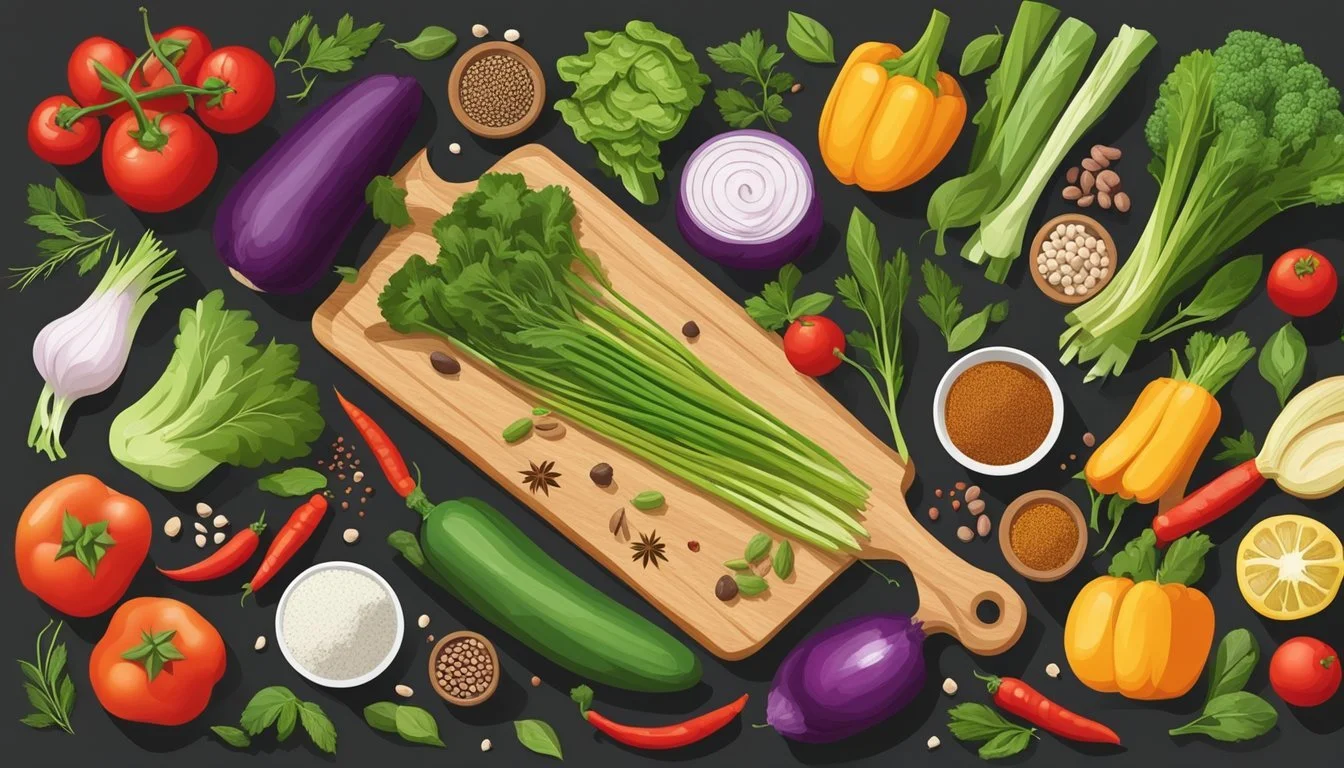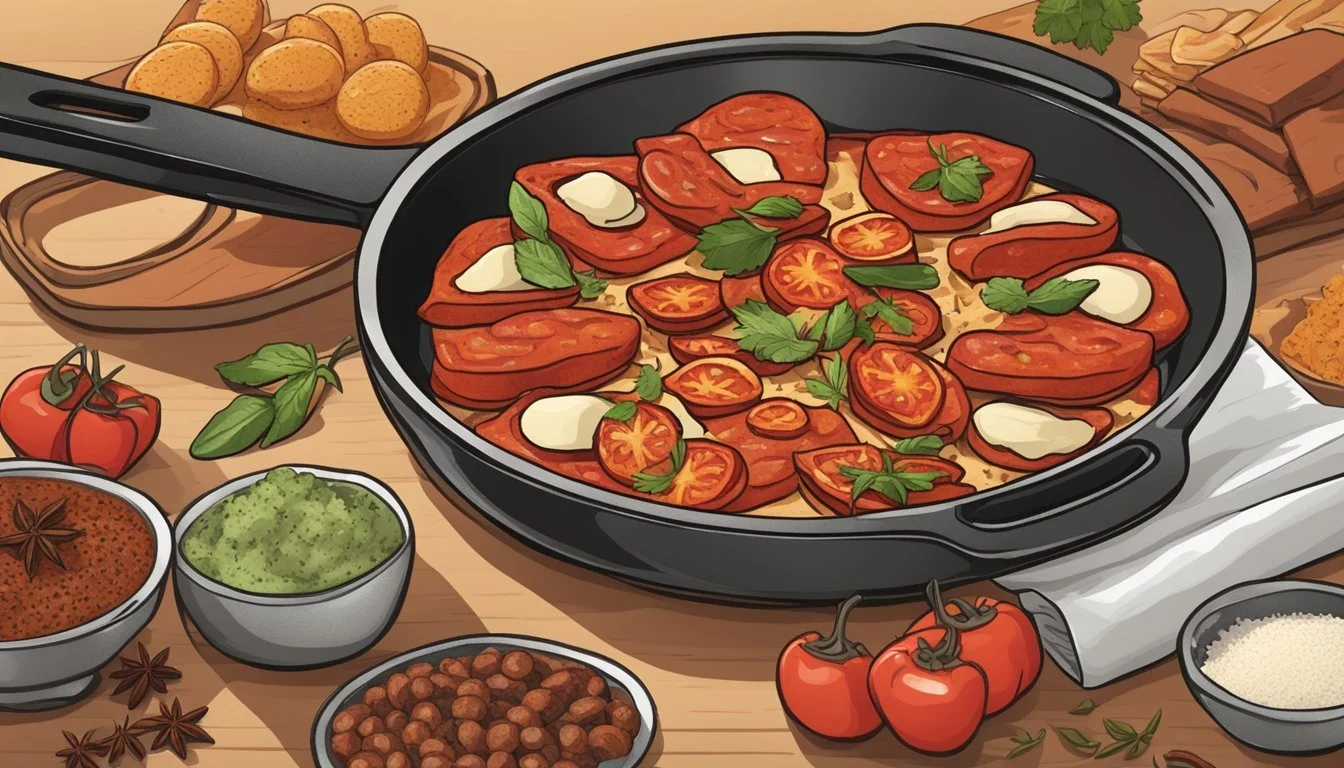Pepperoni Substitutes
Top Alternatives for Every Diet
Finding the perfect substitute for pepperoni can elevate your culinary experience, transforming your dishes with new flavors and textures. Whether you're seeking alternatives due to dietary restrictions or simply craving variety, there are numerous options to explore. Some of the best substitutes include pancetta, spicy salami, and prosciutto, each offering a unique twist to your recipes.
Pancetta, often referred to as Italian bacon, provides a rich and savory taste that's perfect for a 1:1 substitution. If you prefer something with a bit of heat, spicy salami can bring a zesty and robust flavor to your dishes. For those who enjoy a more delicate and salty profile, prosciutto is an excellent choice.
Beyond these traditional meats, there are also vegan options available, such as mushroom or vegan pepperoni. These alternatives not only cater to plant-based diets but also provide essential nutrients like vitamin B12. Experimenting with these substitutes can help you discover new favorites and add variety to your meals.
Understanding Pepperoni
Pepperoni is a popular cured meat known for its use in American cuisine, particularly on pizza. This delicious meat is characterized by its savory and salty flavor, with a blend of spices that often includes paprika and fennel.
In Italy, traditional pepperoni was crafted with a coarser grind and a robust blend of spices, including chili flakes. This imbued the meat with a distinctive taste that has become iconic.
Pepperoni is made from a combination of pork and beef. The mixture is cured, meaning it undergoes a preservation process involving salt, spices, and sometimes sugar. The curing process enhances the flavor and prolongs the shelf life.
One of the primary seasonings used in pepperoni is paprika, which contributes to its vibrant red color. Other seasonings may include garlic, fennel seeds, and various herbs to round out its savory profile.
When it comes to texture, pepperoni has a crisp, meaty bite that adds a pleasing contrast to the soft, chewy crust of a pizza. It is often sliced thin for use as a topping, allowing it to crisp up perfectly when baked.
In addition to pizzas, pepperoni is commonly used in sandwiches and pies, adding a bold and spicy kick to any dish. Its fat content—including saturated fat—and its sodium levels make it a rich and indulgent ingredient, though it is best enjoyed in moderation.
Here's a quick breakdown of some key ingredients typically found in pepperoni:
Ingredient Purpose Pork & Beef Main meat component Salt Preservation and flavor enhancer Paprika Color and flavor Fennel Seasoning Garlic Adds depth to flavor Chili flakes Contributes heat
Pepperoni's enduring popularity is a testament to its unique blend of flavors and its versatility in many dishes.
Health and Dietary Considerations
It's important to understand the nutritional differences between pepperoni and its substitutes, especially for those with specific dietary needs. Some options offer lower calories, fat, and sodium, while others cater to gluten-free or plant-based diets.
Nutritional Profile of Pepperoni
Pepperoni is high in calories, fat, and sodium. An ounce typically contains 138 calories, 12 grams of fat, and 493 milligrams of sodium. This can be a concern for individuals monitoring their fat and sodium intake. It also has high saturated fat content, contributing to increased cholesterol levels. Pepperoni offers some protein, but its high sodium and saturated fat make it less desirable for health-conscious individuals.
Substitutes for Health Conscious Individuals
For those looking to cut down on fat and sodium, alternatives like chicken breast and vegetarian pepperoni are viable options. Chicken breast, for example, provides 133 calories per half-cup, with only 5 grams of fat and 60 milligrams of sodium. Vegetarian or vegan pepperoni options often use ingredients like vital wheat gluten or tofu, offering a lower calorie and fat profile while still providing essential nutrients like protein and fiber.
Understanding Gluten in Pepperoni Substitutes
Most traditional pepperoni contains no gluten. However, some substitutes, especially plant-based options, may contain gluten due to ingredients like wheat gluten. Gluten-free substitutes are available and often made from soy, lentils, or other gluten-free grains. Checking labels for gluten content is crucial for those with gluten sensitivities or celiac disease.
Choosing substitutes that cater to dietary needs without compromising taste or texture is possible.
Pepperoni Substitutes for Different Diets
Finding a suitable pepperoni substitute depends largely on dietary preferences. For those limiting meat intake, vegan and vegetarian alternatives are popular. For meat-eaters seeking lower fat options, specific cured meats offer flavorful choices.
Vegan and Vegetarian Substitutes
Vegan pepperoni and vegetarian alternatives provide excellent options for those avoiding meat. Products made from vital wheat gluten, commonly known as seitan, mimic the texture of traditional pepperoni. Brands also use textured vegetable protein and tofu to achieve a savory, spiced taste that resembles the original.
Another popular option is tempeh, which is fermented soybeans. It retains a firm texture and readily absorbs spices used in pepperoni seasoning.
Alternatively, some products combine ingredients like mushrooms and beans to provide both texture and rich, umami flavors. These choices help in maintaining the nostalgic flavors of pepperoni in pizzas and pastas without compromising on dietary restrictions.
Meat-Based Lower Fat Alternatives
For those looking to reduce fat intake, turkey pepperoni and chicken-based substitutes are leaner alternatives. They offer a similar flavor profile to pork pepperoni but with reduced fat content. This makes them appealing for those on calorie-controlled diets.
Pancetta and prosciutto are also good options. While these are still pork products, they are typically leaner than traditional pepperoni and can be sliced thinly to reduce fat per serving.
Mortadella and leaner salami varieties also provide bold flavors in a slightly healthier package. These meats can be used in a variety of dishes, from pizzas to salads, offering versatility and flavor with fewer calories.
Guanciale, although richer than turkey options, has a robust flavor that can be used sparingly to amp up the taste without adding much fat.
Cooking and Usage Tips for Pepperoni Alternatives
Using substitutes for pepperoni can enhance various dishes with unique flavors and textures. Selecting the right alternative and implementing proper cooking techniques are key to achieving desirable results.
Incorporating Substitutes in Recipes
Choosing the right substitute depends on the dish. For pizza toppings, spicy salami or pancetta provide a savory, smoky flavor. Prosciutto and mortadella bring a delicate or slightly sweet taste, ideal for salads and sandwiches. Dry-cured options like coppa or capocollo work well in pasta dishes and baked recipes.
When incorporating substitutes, consider texture as well. Salami and coppa provide a similar chewiness to pepperoni, while prosciutto offers a more tender bite.
Adjusting Flavor and Texture
Adjusting the flavor and texture of substitutes can optimize their use. For a spicier profile, spicy salami or pancetta can replace pepperoni in recipes needing extra heat. Adding a dash of red pepper flakes or smoked paprika enhances this effect.
For a sweeter flavor, mortadella or prosciutto can be paired with dried fruits or honey-glazed vegetables. Balancing textures is also crucial; for instance, mixing crisp vegetables with soft mortadella creates a harmonious salad.
Preparation Techniques
Different preparation techniques are needed for various substitutes. Salami and coppa can be sliced thinly and used directly on pizza dough before baking. Prosciutto should be added after cooking to maintain its delicate texture.
When using pancetta, it's important to cook it beforehand until crispy, then add it to the dish. This timely cooking ensures its flavors are fully released and integrated. Mortadella can be diced and lightly sautéed for a few minutes to enhance its flavors in pasta dishes.
By carefully selecting and preparing pepperoni substitutes, you can enrich your recipes with varied flavors and textures, offering a delightful culinary experience.
Alternative Ingredients for Homemade Substitutes
Creating your own pepperoni substitute at home offers the flexibility to tailor flavors and textures to your preference. The following sections cover plant-based ingredients, seasonings and spices, and binding agents and texturizers, which are essential for making a flavorful and satisfying alternative.
Plant-Based Ingredients
For a vegan pepperoni, tofu and seitan are popular choices. Tofu, when pressed to remove excess water, absorbs flavors well and can be easily seasoned. It provides a good base for seasoning with a texture that holds up to baking.
Seitan, made from vital wheat gluten, gives a chewier, meat-like texture, making it an excellent substitute for traditional pepperoni. Seitan can be complemented with other ingredients such as mushrooms to add depth and umami to the flavor profile.
Mushrooms also serve as a tasty plant-based alternative due to their rich, savory taste. When finely chopped and combined with the right seasonings, mushrooms can mimic the earthy and slightly spicy notes found in pepperoni.
Seasonings and Spices
Key seasonings and spices are crucial to achieving the distinctive flavor of pepperoni. Smoked paprika and liquid smoke are essential to impart a smoky taste. Garlic powder, onion powder, and black pepper provide the necessary pungency and heat.
Red pepper flakes add the characteristic spiciness, while fennel seeds can introduce a hint of sweetness and complexity, similar to Italian sausage. Ground mustard is used to balance out the flavors, ensuring the final product is flavorful and aromatic.
Combining these spices with plant-based ingredients helps to recreate the traditional pepperoni flavor, making the substitute indistinguishable from the original in taste.
Binding Agents and Texturizers
Binding agents and texturizers are necessary to ensure that the pepperoni substitute holds together during cooking. Vital wheat gluten is commonly used with seitan to give a firm, chewy texture.
For a vegan option, combining tofu with nutritional yeast can add both texture and flavor. Water is often used to help mix ingredients evenly, while parchment paper ensures even cooking and prevents sticking during baking.
By carefully selecting and combining these ingredients, you can create a homemade pepperoni substitute that is both delicious and structurally sound, perfect for topping pizzas or incorporating into various dishes.
Purchasing and Storing Alternatives
Finding the right pepperoni substitutes can elevate your culinary creations, but knowing where to buy these items and how to store them is crucial to maintain their quality and flavor.
Where to Buy Substitute Products
Pepperoni substitutes such as salami, pancetta, and prosciutto can be found in most grocery stores that carry a comprehensive selection of Italian meats. Specialty food stores and delicatessens often have a wider variety, including mortadella and coppa.
For those seeking vegan or gluten-free options, health food stores and online retailers offer a range of plant-based pepperoni alternatives. Look for these products in the refrigerated or frozen sections, or in specialty diet aisles. Ordering online can also provide access to niche brands and varieties not available locally.
Shelf Life and Preservation
The shelf life of pepperoni substitutes varies based on the type and storage method. Cured meats like salami and coppa can last for several weeks in the refrigerator if kept in airtight packaging. Once opened, consumption within a week is recommended to enjoy optimal freshness.
Pancetta and prosciutto should be stored in the coldest part of the fridge and kept tightly wrapped. Plant-based substitutes often have a shorter shelf life; check the packaging for specific guidelines. Many of these products can also be frozen, extending their usability for several months. Proper storage and handling ensure that your substitute for pepperoni remains safe and delicious to eat.
Cultural and Regional Variations
Pepperoni's diversity and adaptation across different cultures highlight various curing and spicing techniques. Many global cuisines have their own equivalents to pepperoni, each bringing unique flavors and styles derived from local ingredients and traditional practices.
International Pepperoni Equivalents
Various international equivalents of pepperoni exist, influenced heavily by local culinary traditions. In Spain and Mexico, chorizo stands out with its rich, smoky flavor and heavy use of paprika. This sausage can be fresh or cured, offering versatility similar to pepperoni.
In Italy, cured meats such as coppa, pancetta, and guanciale offer distinctive flavors. Capocollo (or coppa) is a dry-cured pork neck showcasing a balance of fat and meat, contrasting with more common pepperoni profiles.
These international variations are not just substitutes but also enhance dishes by introducing new tastes. Each brings a touch of its region's essence, from Spanish spiciness to Italian richness.
Regional Curing and Spicing Techniques
Curing and spicing techniques vary across regions, significantly impacting the flavor and texture of pepperoni substitutes. In traditional Italian cuisine, pancetta is cured with salt and spices then dried for weeks to develop complex flavors. Guanciale, made from pork jowl, follows a similar curing process, emphasizing a delicate balance of fat and meat.
Spanish chorizo typically uses a blend of paprika, garlic, and herbs, and it's often smoked, offering a robust flavor profile. In Mexico, a variety of chorizo exists, featuring a spicier, more herbaceous taste due to different regional spices.
These methods show how local ingredients and traditions lead to a rich diversity in cured meats, offering unique options that capture the essence of different culinary heritages.







